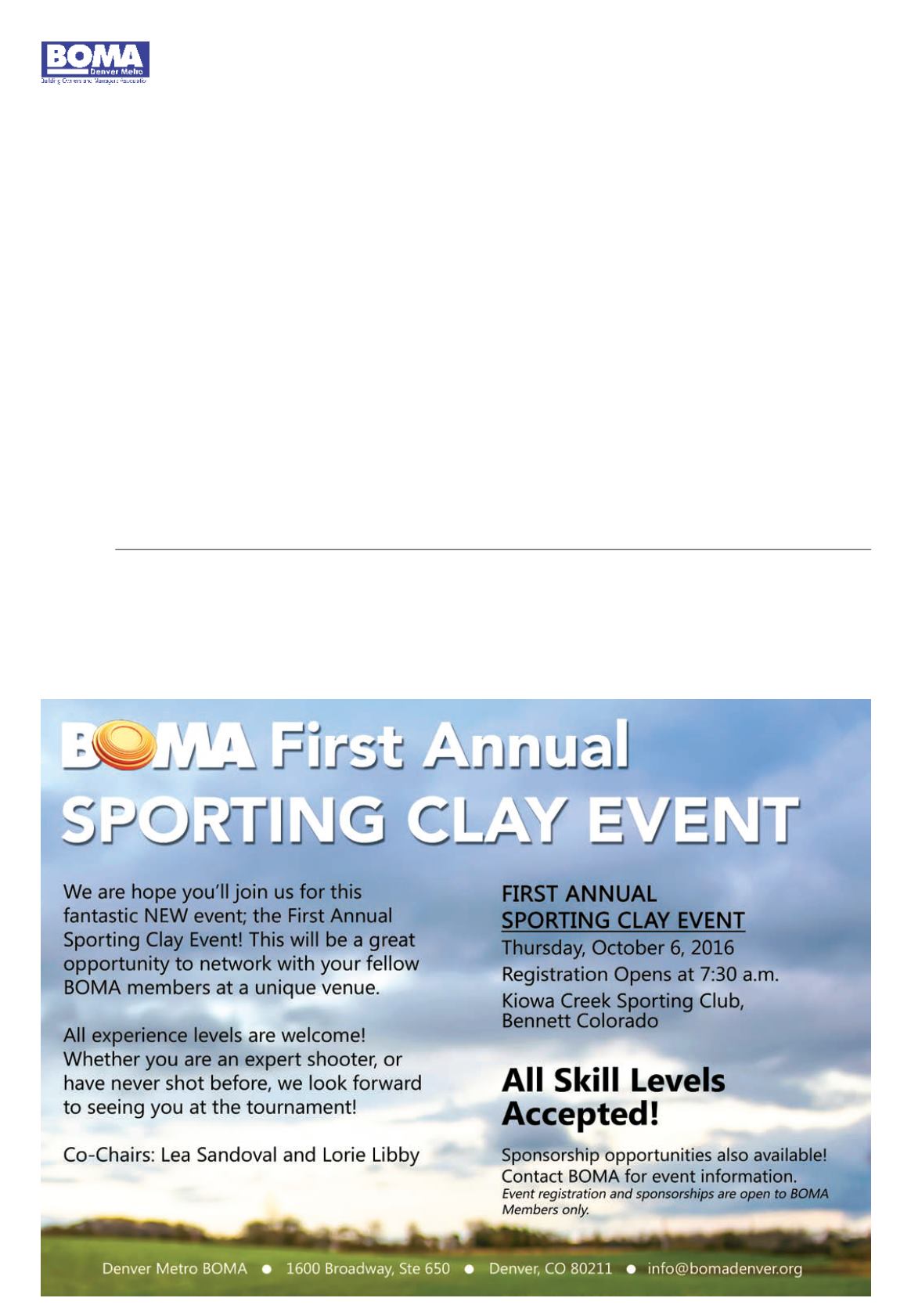
Page 14B —
COLORADO REAL ESTATE JOURNAL
— September 21-October 4, 2016
Spotlight
• OpEx –
Operating
Expenses – Ongoing costs for
operating a property such as
payroll, repairs and mainte-
nance, and utilities.
• NOI –
Net Operating
Income – Calculated by sub-
tracting operating expenses
from gross income from rents
and other sources.
• CapEx –
Capital Expense –
Costs incurred by acquiring or
upgrading an asset, expected
to produce a return in the
form of increase profit.
• RFI –
Request for
Information – Requests from
the contractor and/or subcon-
tractors for clarification of
specifications contained in the
bid. This also can be an invita-
tion to contractors to submit
information about their firms.
• RFP –
Request for Proposal
– A comprehensive document,
or bid package, provided
to prospective contractors
that defines the scope of the
desired services and describes
the evaluation criteria and
evaluation method that will be
used to select a contractor.
• LOI –
Letter of Intent – An
informal unilateral offer to
lease, provided that the land-
lord meets certain conditions.
An LOI is nonbinding and
expires if the tenant and land-
lord do not enter into lease
negotiations within a time
period specified in the letter.
• Absorption –
The amount
of space that is leased and
taken off the market during a
given period of time, usually
quarterly or annually.
• Tl –
Tenant Improvement
– Construction or alteration of
space to meet a tenant’s needs,
according to the terms of the
lease. Also called tenant build-
out.
• Gross Lease –
Tenant pays
only base rent and not oper-
ating expenses (although in
some markets, tenant may be
responsible for future increas-
es in operating expenses above
base year). Also referred to as
“full service” lease.
• NNN Lease –
Triple Net
Lease – In addition to base
rent, tenant pays for its pro-
rata share of taxes, insurance
and, sometimes, even minor
repairs and maintenance.
• R/U Ratio –
The ratio
between the common area and
rentable area of a building
• Turn Key –
Tenant
improvements for which a
landlord agrees to provide and
pay for all components and
labor.
• COI –
Certificate of
Insurance – Written verifi-
cation of types, terms and
amounts of insurance carried
by the named insured, which
is sent to those who require
proof of such coverage.
• Additional Insured –
A per-
son or business entity, other
than the named insured, that
has certain rights and cover-
age under an insurance policy.
• Work Letter –
Letter
attached to a lease as an
exhibit that describes tenant
improvements the landlord is
required to make. Describes
the work to be done, who con-
ducts it, who bears the cost,
start and completion dates,
etc.
• Retainer –
Percentage of
contractor/payment that is
held back until the construc-
tion project has been complet-
ed. Typically 10 percent of the
contract cost.
• Default –
Occurs when a
debtor has not met the legal
obligations according to a
contract, such as not making
a scheduled payment, or has
violated some other conditions
of the contract.
• ROI –
Return on
Investment – Calculation used
to gauge performance of an
investment, made by divid-
ing the total profit by total
amount originally invested.
• Base Year –
A base
amount of operating expenses
used as a foundation for calcu-
lating a long-term lease. The
base year typically is the cal-
endar year in which the lease
is signed.
• Escalation –
Calculation
of operating expenses above a
certain threshold that can be
passed on to the tenant.
• CAM Expenses –
Common
Area Maintenance Charges –
Expenses incurred to maintain
the sidewalks, parking lot,
landscaping, and other com-
mon areas and common build-
ing systems.
• Gross Up –
A provision
that adjusts the operating
expense reconciliation process
for gross leases if the building
occupancy is lower than a cer-
tain threshold.
• Cap –
A limit on operating
expense amounts that can be
passed through to the tenant.
• As-Built Drawings –
Indicate how a building or
space was actually built ver-
sus how it was designed to be
built.
• CDs –
Construction
Documents – Comprehensive
drawings completed by an
architect and engineers, which
define the exact scope of work
for a tenant improvement
project.
• O&M Plan –
Operations
and Management Plan – A
formulated plan of training,
cleaning, work practices and
surveillance to successfully
manage a hazardous sub-
stance or situation.
management industry.
It is not too late to be part
of Denver Metro BOMA’s
Emerging Professional Group.
The group aims to develop and
strengthen the knowledge and
skills of the future leaders of
real estate. Events often are
free to employees of BOMA
member buildings and educa-
tion sessions are designed to be
targeted, hands on and interac-
tive with content designed for
real estate professionals with
less than seven years of real
estate experience.
Any employee of a BOMA
member building may attend
an EP event. Most events are
limited to principal members
but some offerings will be
available to Allied members as
well. Participants have ranged
from administrative assistants
to property managers to chief
engineers.
If you would like to receive
notifications of Emerging
Professional events, please
email your contact information
t
and
state: “I want to be a part of the
EP group.”
You can also follow the
Emerging Professional Group
and Denver Metro BOMA
on Twitter, Facebook and
LinkedIn. If you’d like to take
an active role in planning EP
activities, we’d love to have you
join us for a committee meeting.
The BOMA office can provide a
current meeting schedule.
Active


